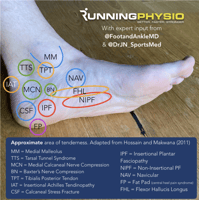(Original Post Date: 12/27/22)
Sciatica: A Pain in the Rear
(Original Post Date: 1/25/23)
The odds are high at some point in your life you will experience an achy pain in the buttock that can radiate down the leg. Sciatica is an annoyance and can vary from mild discomfort disrupting our recreational activities to severe pain interfering with basic daily tasks.
What is it?
The general term of sciatica still applies and is used in academia. The more technical synonym in medicine is radiculopathy. These two terms describe an irritation of the nerve root just outside of the spine.
The typical culprit is a disc issue causing compression and strain to the sensitive nerve root resulting in pain into the lower leg. This is where the terms herniated, bulging, and sequestered are tossed around to describe the various ways the disc is contacting the nerve.
An angry nerve can present as burning, numbness, tingling, and can even cause decreased motor function (muscle strength?), which can be frightening to experience. However, the majority of these mild to moderate symptoms can be successfully managed without serious medical intervention.
Should I have Surgery?
In short, probably not. The average length of mild to moderate radicular pain is 4-12 weeks.
A common pitfall is to have an MRI to discover the disc contacting the nerve and believe the best solution is to cut open the body and remove the offending material. Your body is amazing at healing itself and has the ability to clear out disc tissue with proper care, time, and an active approach to therapy.
Another piece of this sometimes confusing puzzle is that many of us are walking around with disc lesions without any pain or dysfunction. Imaging tends to open up the box of a lot of treatable looking “problems” via surgery and oftentimes is not the source of pain.
There is significant research in the surgical vs. conservative management with two findings being consistently supported in the literature.
- Surgery may lead to quicker symptom reduction in the short term.
- At one year follow up, there is no significant difference between surgery and conservative exercises.
When should surgery be considered?
Severe radicular symptoms that would warrant immediate medical intervention would be loss of bowel or bladder function and the onset of paralysis that persists or worsens, but the vast majority of cases are best treated with conservative care. A good PT should be able to recognize these cases and refer out to the appropriate provider.
Should I have an Injection?
Short term outcomes for injections are favorable in cases where there are severe daily activity limitations and sleep disturbances. If the pain is preventing an individual from moving, going to work, and sleeping, being able to minimize symptoms and allow for movement is key for long term success. This is where an injection can be of benefit in the short term
Medications like oral steroids and muscle relaxers have less favorable outcomes. Quality research studies indicate these medications don't outperform placebo treatment, meaning eating a tic tac thinking it's going to help the pain is just as powerful as the actual drug.
Structured Exercise
The gold standard for mild to moderate sciatica is structured exercise. This is where a plethora of “it depends” statements begin but people experience the best outcomes with a trained professional to treat their unique case.
The structure piece indicates that a customized plan is superior to simply “staying active” advice and beats out generic online programs.
It’s important for an exercise program to be catered to the individual and be structured to normalize daily activities and work towards their specific end goals.
If you or a friend are dealing with sciatica, we can help! Contact us at admin@steadystatehealth.com or click below to set up a free 20-minute discovery call to get started.




